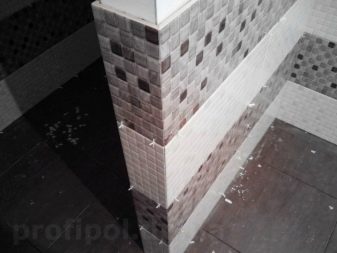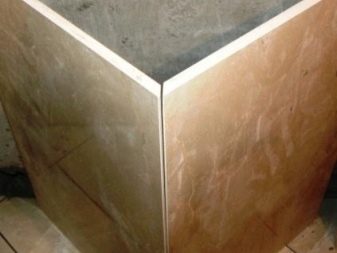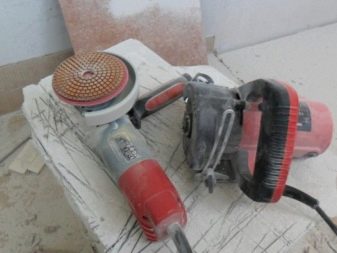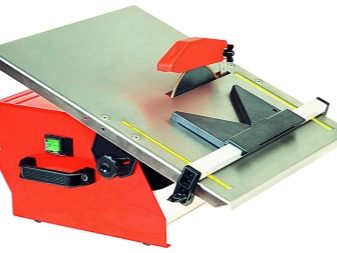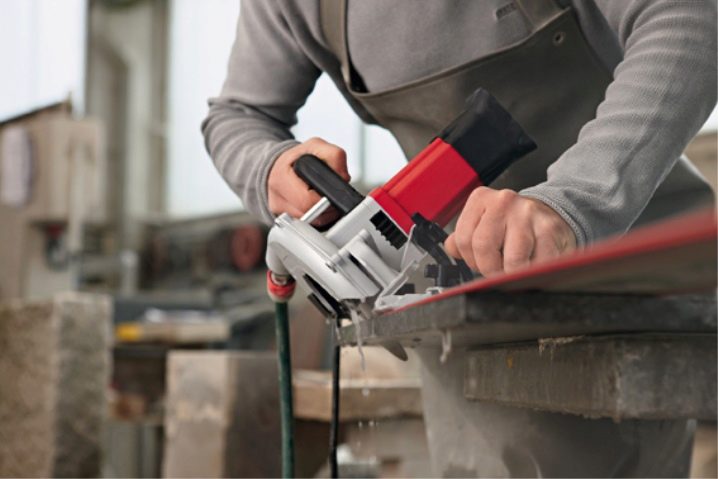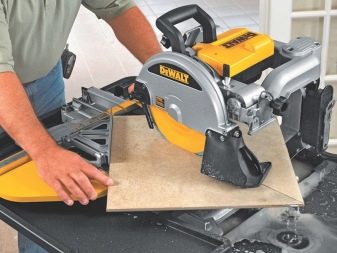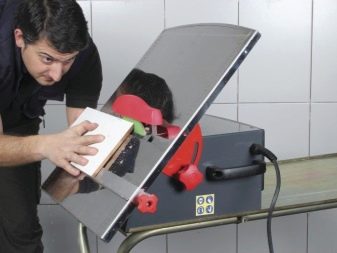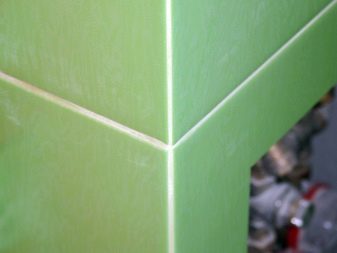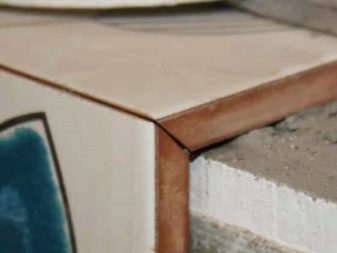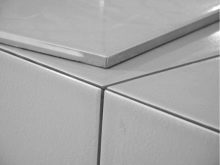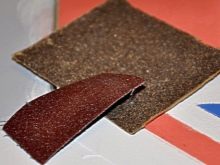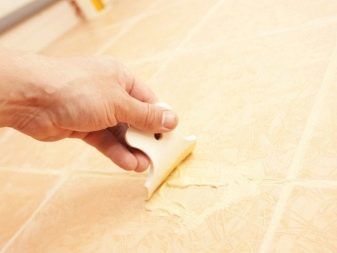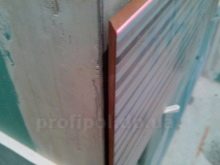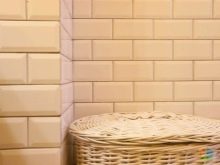How to make washed down tiles at 45 degrees?
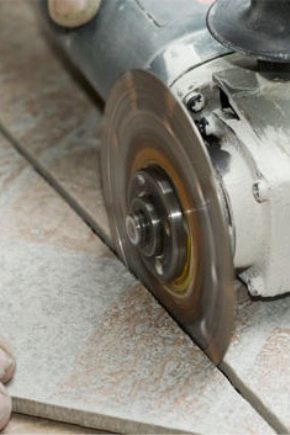
Modern design projects require masters of various skills, including the processing of tiles. To work with a tile, very often it is necessary to make it washed down under 45 degrees. Thanks to this technique, it is possible to veneer with such material various protrusions and niches, the corners between the wall and the floor. Also, trimming at an angle is needed when you want to create an unusual clutch. Let us consider in more detail how this is done correctly, and also with the help of what tools all the work is done.
When do you need tile cutting?
It is necessary to resort to this method of tile processing in various cases when it is necessary to create a beautiful right angle. For example, when it is planned to lay tiles on the wall and on the floor, when you need to veneer the ventilation duct on the floor or the recess for pipes. In modern apartments you can find various design features, and this means that variations in the use of tile are significantly expanding.
Using this method of sharpening, the interlayer joint looks neater, and the edges of the tiles at the joint are more tightly closed with grouting, which reliably protects them from moisture or accidental impacts.
Cutting tiles at an angle of 45 degrees is done in case you want to put the finish in an unusual way., for example, diagonally. To do this, you can use both square and rectangular tiles. The latter will allow you to create unusual ornaments (and even the effect of the “parquet Christmas tree”).
Grinder for gash
The usual Bulgarian is in the arsenal not only of professional finishers, but also of amateurs. It should be equipped with a diamond disc. Place the tile under the edge face down.The tool must be adjusted revolutions, then to achieve the desired angle will be easier. In this case, first you need to set the minimum figure so as not to melt the edges. When the desired angle will be ground, walk around it with a diamond disc again to polish it. Can be used for sanding files, or sandpaper.
There are also special nozzles for grinding. It is easy to replace them - the basis with a flypaper is established on a carving of the Bulgarian. They are not as durable as diamond "turtles", but they are cheaper. For those who do not repair on an industrial scale, this may be enough.
Many people prefer to use a mask or respirator when working with a grinder. This tool produces too much dust, which is not recommended for breathing.
How to use the grinder?
Let us consider in more detail how to use the grinder when working with tiles:
- The tile should stand in a vice vertically. Put the diamond disc, and then select the mode of operation 1000-2000 revolutions per minute.
- Remove the angle with the part of the disc on which the notches are applied.
- The tool should be placed at an angle of 45 degrees (relative to the frontal plane of the tile).
- Remove the excess smooth touch, so that every time the surface goes on the thinnest layer, without reaching the edge of the outer side of the corner.
- Edge thickness (about 2 mm) should remain intact. You can mark this distance with a pencil.
At the second stage, a support plate is installed on the grinder. A circle with sandpaper is placed in the center of the support plate. Now you can bring the edge, and then create the most acute angle.
Electric tile cutters washed down
As the name implies, a tile cutter is a more specialized tool, which means that you can make tiles with it more qualitatively. Of course, not everyone will buy it for a single use. If we are talking about a quality model with additional features, this tool will be quite expensive. In addition, you can achieve really good results with experience, so you have to spend some time to acquire the necessary skills.
If we are talking about professional finishers, then they should have an electric tile cutter in their arsenal. Cutting a tile with it takes less time, and such a machine leaves less dust.
The tile cutter works in two modes:
- for direct gash;
- for washed down at the right angle.
With it, you can cut strips thinner than 5 mm, even with solid tiles. To avoid melting, water flows to the cutting site. Also, it immediately removes dust and debris.
Using tile cutter
To learn how to work properly with this tool, you need to follow a certain order of actions:
- The masking tape is stuck on the tile in place of the cut.
- Mark the desired trim width on the tile with a pencil and ruler.
- Place it on the tool platform.
- Squeeze the tile and gently move it to the disk. First, you need to cut down too much, and then engage in grinding angle.
- It is necessary to prevent the touch of the glaze, otherwise the edges will look uneven. If nevertheless the surface decorative layer of the tile was touched, then with sufficient skills it can be sanded with sandpaper.
How to achieve a perfect right angle at the junction?
If you want to create a flat joint, you will have to work as carefully as possible:
- To begin with, the first tile is attached using a building level. Its edge should slightly go beyond the plane of the corner of the base.
- After that, the second side of the corner is aligned.Each tile adhesive has its own hardening time, so much is given to you to trim the resulting angle.
- By the same principle the subsequent fragments of tile are glued. The main thing is that the vertical of the walls was initially sustained, otherwise it would be practically impossible to hide the defect from the unsuccessful joints.
Keep in mind that at the joints after the sawing tile becomes more fragile. For this reason, such stacking is usually not used on surfaces experiencing a large impact load. Especially rarely it is used when facing steps. So, when designing street stairs, builders most often use metal corners, and sometimes lay tiles overlap so that the top module protrudes slightly above the side module.
Another way to create an oblique edge:
If you want to make trimming a fragment of ceramics with your own hands in a simpler way, then there is another option. To do this, draw a glass cutter line on the decorative side of the tile. After that, turn it on the wrong side to yourself, and then with the grinder, make a V-shaped notch across the entire width of the tile. Now you can break off the surplus, as well as do fine-tuning using sandpaper.
It is recommended to use sandpaper No. 40 or No. 60 - for a rougher process, or No. 80 - for finishing the edges.
Tips from experts
To work with porcelain stoneware, it is preferable to use a professional electric tile cutter, as it is adapted to work with harder material. Yes, and this material is more expensive, so I want to minimize its losses during processing.
When gash angle can be done not 45 degrees, but sharper. This makes it easier to glue tiles at a right angle.
When working with bevels at the corners, high-quality grouting is very important., because you can even hook on the tile with the gash with a belt from clothes. This may result in the breaking off of its fragment. If the chip still happened, but at the moment you are not going to replace this tile, the grout will help to hide the defect. They are available in different colors, so choosing the right option for the color of ceramics is not difficult. There is also another option: use any available grout and tint it with paint of the desired shade on top.
When, after laying tiles on the seams, minor flaws can be seen, for example, from unsuccessful polishing of the glaze, you can use masking compositions that will hide imperfections.Such corrective means are easy to use - as a rule, there is a small brush in the cap. The main thing is to carefully study the instructions. Note that we are talking about very minor flaws, and not about chipped pieces of ceramics. Corrective tool will become an indispensable tool, if you need to "discolor" a small crack on the tile, and even on any ceramic product.
Using the technology washed down the tiles at 45 degrees allows you to make a good repair - this option looks more expensive and generally more advantageous than plastic corners at the joints.
With enough experience working with finishing materials, you can do everything yourself. If you do not have the necessary qualifications, and finances allow you to hire experienced workers, then it is better to trust the professionals - then you will have no doubt about the quality of the work.
How to make washed down tiles at an angle of 45 degrees, see below.
